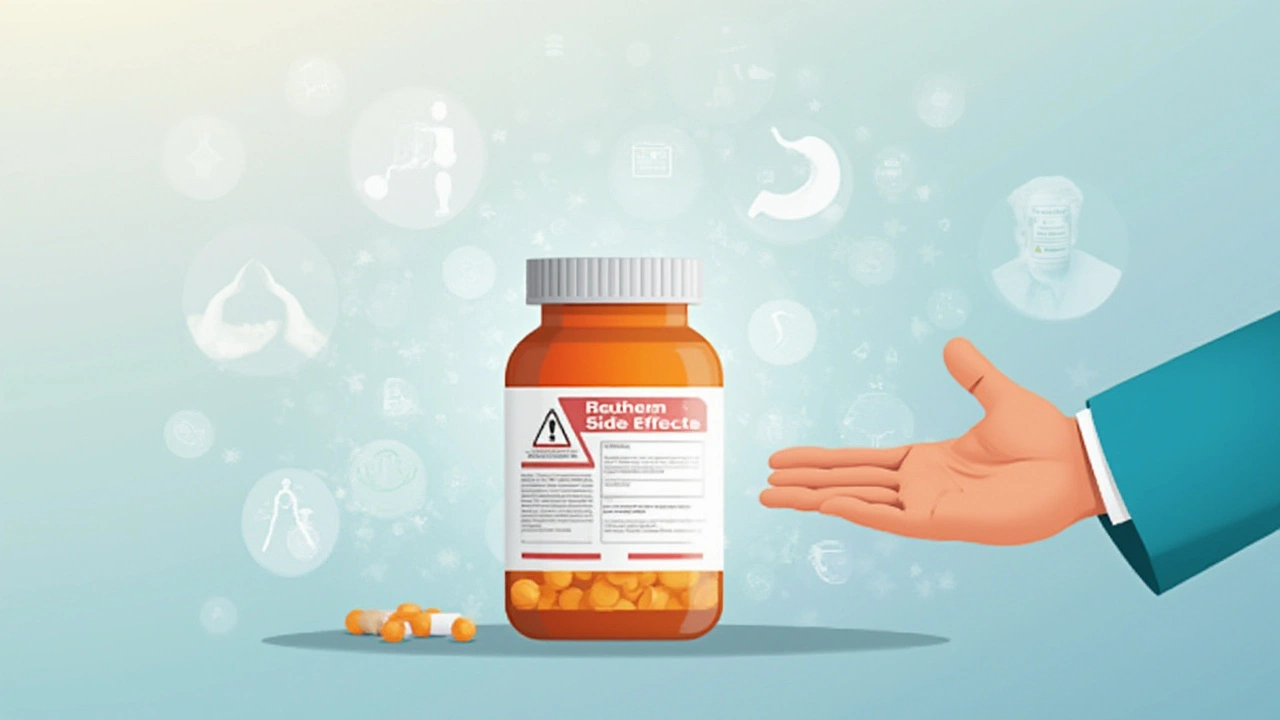Ever stuck reading that little fold-out paper from your diabetes pills, squinting at words like “pancreatitis” or “lactic acidosis” and thinking, Should I be worried? You’re not alone. There’s so much hidden behind those small warnings—and sometimes it feels like you practically need a PhD just to understand the risks. But honestly, if you or someone you love has type 2 diabetes, it pays to know exactly what might happen when you pop those daily tablets.
How Diabetes Pills Work and Why Side Effects Happen
Your body is supposed to balance blood sugar on its own, but with type 2 diabetes, that gets tricky. Most diabetes pills either nudge your pancreas to pump out more insulin, help your body use insulin better, or stop your liver from dumping extra sugar into your blood. But since your body is full of moving parts (think organs, hormones, nerves, and more), changing one thing often throws another a little off-kilter. That’s where side effects step in.
Take metformin, for example. It’s practically the MVP of type 2 diabetes meds—doctors give it to millions of people every year. It mainly tells your liver to stop releasing so much glucose and helps your cells suck up sugar from your blood. But it can also make your stomach grumpy: almost a third of people get some sort of digestive issue, like nausea or diarrhea, especially at the start. Usually, your body settles down after a few weeks, but sometimes you just have to ask your doctor if it’s time to switch things up.
Then there are sulfonylureas—glipizide and glyburide are a couple of the classics. These tell your pancreas to send out more insulin. They work, but sometimes a little too well. The most common struggle? Low blood sugar (hypoglycemia), which can make you shaky, sweaty, dizzy, or suddenly hangry in the checkout line. This can be scary, so it helps to carry some fast sugar (like glucose tabs or juice) if you’re taking one of these old-school pills.
DPP-4 inhibitors are a newer class, often with names that end in “gliptin” (like sitagliptin and saxagliptin). These keep a hormone in your gut active longer so your pancreas isn’t working overtime. They don’t usually cause low blood sugar by themselves, but you might get headaches or stuffy nose, and in rare cases, trouble with your pancreas. Curious about specifics? Check out this super thorough list of Januvia side effects to see what’s most common and what truly needs a call to your doctor.
When meds get fancy (like SGLT2 inhibitors), they make you literally pee out more sugar. So, along with better blood sugar, you might deal with frequent bathroom breaks or a higher chance of yeast infections. Luckily, most side effects are mild and fade after your body adjusts, but it’s smart to know what to look out for.
The Most Frequent Side Effects—And How To Deal
There’s a reason stomach complaints top the list. Metformin leads that parade, but even GLP-1 agonists (that shot you might take weekly) make some people feel queasy early on. It often helps to start with a lower dose and ramp up slowly, and eating pills with food can tame your tummy.
Low blood sugar (hypoglycemia) is something you don’t want to ignore. It’s more likely with sulfonylureas and, if you take insulin, can sneak up on you after exercise, a missed meal, or if you drink alcohol. Signs aren’t subtle—shakiness, sudden sweat, blurry vision, even confusion. My son Keiran once described a hypo as “a scary brain-fog fast-forwarded movie.” A quick sugar fix (like a small juice box or a handful of jellybeans) usually sorts you out. But if you ever pass out, that’s an emergency—someone needs to call for help fast.
SGLT2 inhibitors, another newer group, means you might spend more time in the bathroom. That’s those meds encouraging your body to pee out excess sugar. This means more frequent urination but can come with a higher risk of urinary tract infections or genital yeast infections, especially for women. Staying hydrated and good hygiene is key. Women, seriously—bring those gentle wipes when you’re out and about. It makes a difference.
Weight changes also come up a lot. Some diabetes meds can bump your weight up, others help shed pounds. Metformin and SGLT2 inhibitors may make you lose a bit, while some older meds and insulin might cause a few extra pounds to sneak in. It’s not a given, though—lots depends on your food, your activity, your genes. If you notice changes, don’t stress right away. Track what’s happening alongside your meds and talk to your doctor before assuming the pills are to blame.
Here’s a table with side effects you might bump into, and how often they show up (based on big studies):
| Medication | Common Side Effects | Percent Reporting |
|---|---|---|
| Metformin | Nausea, diarrhea, stomach upset | 10-30% |
| Sulfonylureas | Low blood sugar | 12-20% |
| DPP-4 inhibitors | Headache, respiratory issues | 3-7% |
| SGLT2 inhibitors | UTIs, yeast infections, more urination | 8-12% |
| GLP-1 agonists | Nausea, vomiting | 10-20% |
diabetes pills aren’t all bad news—many people only get mild or no side effects and feel much better with steady blood sugars. But tracking symptoms and speaking up makes a big difference.

Uncommon and Serious Risks—What You Shouldn’t Ignore
Most side effects fade or become manageable, but some, while rare, are much more serious. For instance, metformin usually just gives you gas at worst, right? But in people with bad kidneys or liver, it can (in extremely rare cases) cause lactic acidosis. This is super dangerous, but we’re talking less than 1 in 10,000 people. Symptoms are deep fatigue, muscle pain, and fast breathing—go to urgent care right away if you feel that and have risk factors.
SGLT2 inhibitors have their own rare drama: diabetic ketoacidosis, even if your blood sugar isn’t sky-high. If you notice unrelenting nausea, stomach pain, or deep rapid breathing, especially if you have a fever or other illness, you’ll want to get checked. For women, there’s a small but real risk of kidney issues, and necrotizing fasciitis of the perineum (Fournier’s gangrene), which sounds terrifying because, honestly, it is. But again, so rare your doc likely won’t see it once in their whole career.
DPP-4 inhibitors like sitagliptin can rarely cause inflammation of the pancreas (pancreatitis), which means sudden intense abdominal pain that you just can’t ignore. There are also case reports about joint pain appearing out of nowhere, so if your knees or hands start hurting after starting one of these, it’s worth mentioning at your next visit.
Allergic reactions are also a wild card for any med. Swelling, itching, rash, or problems breathing—call for help. Don’t try to "wait it out." In clinics, we see less than 0.1% of people with this serious reaction, but because it’s so unpredictable, people need to be aware.
Here’s a quick summary of rare, but important risks by drug:
- Metformin: Lactic acidosis (very rare, mostly in kidney/liver problems)
- SGLT2 inhibitors: Ketoacidosis, severe urinary/genital infections
- DPP-4 inhibitors: Pancreatitis, severe joint pain
- Sulfonylureas: Prolonged hypoglycemia (if dose too high or not eating)
- GLP-1 agonists: Gallbladder problems, possible thyroid risk (studied in animals)
If you ever see dark urine, yellow eyes or skin, swelling, or trouble breathing after going on a new medication, get checked ASAP. It’s not likely, but it’s not worth guessing.
Tips for Managing and Avoiding Side Effects
Okay, so you want to avoid these issues if you can help it? A few simple strategies can make all the difference. First, always start low and go slow with any new med. Doctors usually get this right, but if you’re sensitive, don’t be shy about asking for the smallest starting dose. Your system will thank you.
Take your meds at the same time daily, ideally with food if they tend to bug your stomach. Skipping meals, especially if you’re on sulfonylureas or insulin, is just inviting a hypo. If you want a glass of wine with dinner—yep, it might dip your sugar too. Track what you’re eating, when you’re active, and how you’re feeling. Most phones have a notes app, and once you get into the habit, it takes less than a minute.
Stay hydrated, especially if you’re on SGLT2 inhibitors. Water helps flush out extra sugar, but if you start to feel dizzy or your urine is super dark, it might be too much. If you’re a woman prone to infections, always wipe front-to-back and avoid harsh soaps down there. I wish someone had told me that before kiddo #1, trust me!
If you’re seeing new meds lined up for you, don’t hesitate to ask your doctor for a trial period. Maybe one med just isn’t right for your gut, or your schedule, or your body. If you’re dealing with recurring side effects, write them down so you and your doc can see if there’s a trend. You’re not being difficult—you’re being a smart patient. They want you to have the most comfortable experience possible. And there are so many choices these days. The old one-size-fits-all idea is history now.
Sharing with other people who take diabetes meds can mean lifesaving hacks: Maybe your neighbor figured out how to avoid the "metformin belly," or your coworker’s tip about always carrying hard candies means you’ve been spared a brutal hypo. There’s value in the human side of medicine. Don’t be embarrassed by questions—your pharmacist, your nurse, your doctor, even a diabetes educator, they’ve seen it all.
Here are some practical reminders:
- Always carry something sweet for emergencies if you’re on sulfonylureas or insulin.
- Keep a list of all your meds in your wallet or on your phone. Handy if something happens.
- If your tummy’s upset from metformin, ask about the extended-release version—it’s often gentler.
- Review any new or unusual symptoms, even if they feel minor, with your medical team.
- Don’t adjust doses yourself. Talk through changes, especially if you’re feeling sick or traveling.
And don’t underestimate how much better you can feel once your blood sugar is under control. The tough part is finding a routine that fits you—and side effects don’t have to stick around forever.

When to Get Medical Help: What’s Urgent, What Can Wait
So, when should you reach for the phone versus waiting things out? Mild stomach aches, headaches, or a bit of lightheadedness after a new med are usually okay if they pass quickly. But, if you throw up repeatedly, have severe stomach pain, chest pain, swelling in your face or throat, or trouble catching your breath, those are reasons to get help now.
If you can’t keep food or liquids down for over six hours, start running a fever, or are having confusion or loss of consciousness, skip the nurse advice line and go straight to urgent care or the ER. Same goes for signs of low blood sugar where you’re not waking up normally—or if a friend passes out after taking diabetes meds.
Even something that feels “weird” or “not right” is worth checking on. Your health team wants to know what you’re going through. They’re there to help you keep yourself safe and make the treatment “yours.” And if you wind up with one of the rare or serious side effects? Getting seen early often means a much easier recovery.
Keep your own notes, talk to people who have been there, trust your gut, and get support. There isn’t one perfect option for everyone, but you have more ways to take charge than ever.

Comments (8)